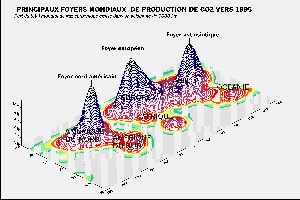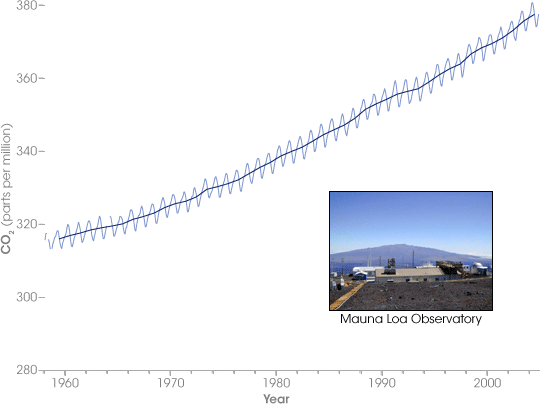 Principaux foyers de CO2 (Grasland)
|
|
(...)il est impossible d'attribuer au réchauffement climatique global
toutes les fluctuations "climatiques" observables à l'échelle du mois ou
même de l'année. Il est trompeur de ne souligner que les phénomènes qui
semblent en accord avec le réchauffement. Ce type de méthode ne
démontre en rien le changement, dont les preuves sont ailleurs (voir le
rapport du GIEC) : séries de données à long terme, compréhension des
phénomènes physiques en cause (l'augmentation de l'effet de serre de
l'atmosphère en premier lieu), capacité de simuler les changements
moyens déjà observés au moyen de modèles représentant ces phénomènes
physiques. (...)
par Pierre Allemand
http://blogs.tv5.org/climats/2008/03/quelques-anomal.html
|
|
"Nous savons, mais nous ne croyons pas ce que nous savons.
Sur le réchauffement climatique par effet de serre,
il n'y a pas d'incertitude sur le fait que nous allons droit dans le mur.
Et pourtant, nous continuons d'agir comme si de rien n'était."
par Jean-Pierre Dupuy
http://www.20minutes.fr/journal/recherche/pop_article.php?ida=60574
|
 (Europe1)
(Europe1)

|
[le sommet de Gleneagles du G8 se tiendra du 6 au 8 juillet 2005]
L'objectif de réduction de gaz à effets de serre et d'atteindre un développement plus durable en matière énergétique a conduit, au cours du printemps, à des rapprochements des vues britanniques et françaises. Les vues américaines, cependant, demeurent en deça, s'agissant de la réduction des émissions de carbone. |
Pour approfondir :
 Le plus grand ennemi de l'homme |
</ul>
URLs on ENVIRONMENT
Env64 September 2005
Climate Data: A Sectoral Perspective.
Prepared for the Pew Center on Global Climate Change by Kevin Baumert,
Jonathan Pershing, Timothy Herzog, World Resources Institute, August
2005
http://www.pewclimate.org/docUploads/ClimateData%2DSectoral%2Epdf
This paper is a companion to an earlier paper, Climate Data: Insights and Observations. (see Env57, January 2005). The earlier report examined global and national-level emissions, energy, and socio-economic data for the world's largest greenhouse gas-emitting countries. This supplement looks at data by sector, again with a focus on major emitters.
Anthropogenic Effects on Tropical Cyclone Activity.
Kerry Emanuel, Massachusetts Institute of Technology, September 2005
http://wind.mit.edu/~emanuel/anthro2.htm
Hurricanes have grown significantly more powerful and destructive over the last three decades due in part to global warming, says an MIT professor who warns that this trend could continue. Theories and computer simulations of climate indicate that warming should generate an increase in storm intensity. In other words, they should hit harder, produce higher winds and last longer.
Availability and Affordability of Insurance Under Climate Change: A Growing Challenge for the U.S.
Evan Mills, et al., CERES, 8 September 2005
http://www.ceres.org/pub/docs/Ceres_insure_climatechange_090805.pdf
This Ceres report focuses on the growing risks that U.S. insurers, government and consumers face from climate change. The report, which includes specific recommendations for addressing this growing insurance challenge, was published in advance of an upcoming meeting of the National Association of Insurance Commissioners at which time the NAIC will be examining the implications of climate change on the industry.
Fuel Economy Fraud. Closing the Loopholes That Increase U.S. Oil Dependence.
Don Mackenzie, et al., Union of Concerned Scientists, August 20, 2005
http://www.ucsusa.org/clean_vehicles/fuel_economy/fuel-economy-fraud-closing-the-loopholes-that-increase-us-oil-dependence.html
This report provides a yardstick for evaluating a proposal from the National Highway Traffic Safety Administration that is expected later this month. Fuel economy standards are the nation's chief tool for reducing America's oil dependence. This proposal is expected to alter the way sport utility vehicles, minivans, and pickups are regulated.
The State of Coral Reef Ecosystems of the United States and Pacific Freely Associated States: 2005.
U.S. National Oceanic and Atmospheric Administration, August 2005
http://ccma.nos.noaa.gov/ecosystems/coralreef/coral_report_2005/CoralReport2005_C.pdf
The nation's coral reef ecosystems continue to face numerous stressors from both natural and human sources including overfishing, disease, pollution and climate change according to a new national assessment of the condition of U.S. shallow coral reef ecosystems. The report indicates that management actions are moving in the right direction. NOAA and federal, state, territory and local partners have begun to implement “local action strategies” to reduce key threats to reefs.
World Resources 2005. The Wealth of the Poor? Managing Ecosystems to Fight Poverty.
World Resources Institute, August 2005.
http://pdf.wri.org/wrr05_full.pdf
World Resources 2005 is the 11th in a series of biennial reports on global environment and governance issues published since 1984. The report explores the following propositions:
Wind Power. Impacts on Wildlife and Government. Responsibilities for Regulating Development and Protecting Wildlife.
GAO, September 2005
http://www.gao.gov/new.items/d05906.pdf
The impact of wind power facilities on wildlife varies by region and by species. Specifically, studies show that wind power facilities in northern California and in Pennsylvania and West Virginia have killed large numbers of raptors and bats, respectively. Studies in other parts of the country show comparatively lower levels of mortality, although most facilities have killed at least some birds. However, many wind power facilities in the United States have not been studied, and, therefore, scientists cannot draw definitive conclusions about the threat that wind power poses to wildlife in general. Further, much is still unknown about migratory bird flyways and overall species population levels, making it difficult to determine the cumulative impact that the wind power industry has on wildlife species. Notably, only a few studies exist concerning ways in which to reduce wildlife fatalities at wind power facilities.
The Political Economy of Mercury Regulation.
Ted Gayer and Robert Hahn, Cato Institute, Summer 2005
http://www.cato.org/pubs/regulation/regv28n2/v28n2-4.pdf
“This paper provided an overview of the costs and benefits of regulating mercury emissions from power plants using IQ gains as a measure of benefits. Our assessment suggests strongly that the benefits are not likely to be worth the costs. This is true both for the command-and-control regulatory regime that was proposed as well as the market-based regulatory regime that was ultimately adopted. However, the market-based approach could reduce the costs of achieving the emissions goal by about $15 billion dollars.”
Evaluating Ozone Control Programs in the Eastern United States: Focus on the NOx Budget Trading Program, 2004.
EPA, August 2005
http://www.epa.gov/airtrends/2005/ozonenbp/
EPA's rule, known as the "NOx SIP Call," has yielded reductions to improve air quality for more than 100 million people. The NOx SIP Call directs 21 eastern states and the District of Columbia to reduce emissions of NOx during the summer months. All states subject to this rule chose to comply by participating in the EPA-administered NOx Budget Trading Program. "The NOx Budget Trading Program is yet another example of how market-based trading programs are significantly reducing emissions of air pollutants," said EPA Administrator Stephen L. Johnson.
Great Lakes Initiative. EPA Needs to Better Ensure the Complete and Consistent Implementation of Water Quality Standards.
U.S. GAO, Report to Congressional Requesters, July 27, 2005
http://www.gao.gov/cgi-bin/getrpt?GAO-05-829
The virtual elimination of toxic pollutants in the Great Lakes is a goal shared by the U.S. and Canada. While some progress has been made, pollution levels remain unacceptably high. The Great Lakes Initiative (GLI) requires stringent water quality standards for many pollutants in discharges regulated by states administering National Pollution Discharge Elimination System permit programs. This report examines the (1) GLI's focus and potential impact on water quality in the Great Lakes Basin, (2) status of GLI's adoption by the states and any challenges to achieving intended goals, and (3) steps taken by the EPA for ensuring full and consistent implementation of GLI and for assessing progress toward achieving its goals.
Sustainability in the Chemical Industry: Grand Challenges and Research Needs - A Workshop Report.
Board on Chemical Sciences and Technology, September 2005
http://www.nap.edu/books/0309095719/html/
Through innovative design, creation, processing, use, and disposal of substances, the chemical industry plays a major role in advancing applications to support sustainability in a way that will allow humanity to meet current environmental, economic, and societal needs without compromising the progress and success of future generations. Based on a workshop held in February 2005 that brought together a broad cross section of disciplines and organizations in the chemical industry, this report identifies a set of overarching Grand Challenges for Sustainability research in chemistry and chemical engineering to assist the chemical industry in defining a sustainability agenda. These Grand Challenges include life cycle analysis, renewable chemical feedstocks, and education, among others.
Unexploded Ordnance Cleanup Costs. Implications of Alternative Protocols.
Jacqueline MacDonald?, Carmen Mendez, Rand Corporation, August 10, 2005
http://www.rand.org/pubs/monographs/2005/RANd_MG244.pdf
Closed military bases must all go through a process of environmental restoration to ensure the safety of the eventual users. This restoration pertains not only to the contamination caused by toxic substances, but also to a hazard unique to military bases: unexploded ordnance (UXO), which occurs when the munitions used in military training or weapons testing do not explode as designed. UXO includes such items as artillery shells, bombs, rockets, hand grenades, and so forth. Clearing the land of UXO is an expensive, time-consuming, and often contentious process. Researchers from RAND Arroyo Center explored the issues related to the cost of cleaning up UXO, focusing on how changes in the cleanup protocols affect costs.
Roadmap to Energy in the Water and Wastewater Industry.
R. Neal Elliott, American Council for an Energy-Efficient Economy, August 2005
http://aceee.org/pubs/ie054full.pdf
Municipal water supply and wastewater treatment systems are among the most energy-intensive facilities owned and operated by local governments, accounting for about 35 percent of energy used by municipalities. Water and wastewater treatment and distribution in the United States is estimated to consume 50,000 gigawatt-hours, representing 1.4 percent of the total national electricity consumption, and to cost over $4 billion annually. However, according to the U.S. Environmental Protection Agency's ENERGY STAR® program, 10 percent savings can readily be achieved in this industry. The report names key stakeholders involved in energy/water decisions, distinguishes key areas of opportunity, and suggests specific action items. It also identifies key areas for further action to advance energy efficiency in the water and wastewater industry.
Invasive Species. Progress and Challenges in Preventing Introduction into U.S. Waters Via the Ballast Water in Ships.
Testimony before the Subcommittee on Regulatory Affairs, Committee on
Government Reform, United States House of Representatives, September
2005
http://www.gao.gov/new.items/d051026t.pdf
Congress recognized ballast water as a serious problem in 1990 with passage of the Nonindigenous Aquatic Nuisance Prevention and Control Act, intended to help reduce the number of species introductions in the Great Lakes. Since 1998, Coast Guard data show that compliance with existing ballast water exchange requirements has generally been high. However, key agencies and stakeholders recognize that the current ballast water exchange program is not a viable long-term approach to minimizing the risks posed by ballast water discharges. Developers are pursuing technologies to provide more reliable alternatives to ballast water exchange, some of which show promise. Several states have passed legislations that authorize procedures for managing ballast water that are stricter than federal ones.


|